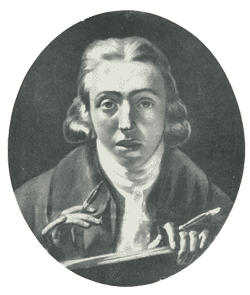Robert Healy (or Haly), Portrait and Animal Painter in chalks
(fl. 1765-1771)
Portrait and Animal Painter in chalks
From A Dictionary of Irish Artists 1913

Robert Healy. Chalk drawing, by Himself; in National Gallery of Ireland.
Trained in the Dublin Society's Schools, he established himself as an artist in Wood Quay, and from there exhibited portrait drawings at the Society of Artists in William Street in 1766 and 1767. In 1768 he was in Essex Quay, and in 1769 and 1770 at No. 2 Dame Street. He exhibited in each of these years portraits in water-colour and in chalk, and in 1770 was awarded a silver palette by the Dublin Society for the best exhibited drawing of a group of figures. Healy enjoyed a considerable practice and had a high reputation for his portraits, both of men and horses, drawn in black and white chalk. His work is effective, though his figures are somewhat stiff; but his portrayal of horses, which was considered his chief excellence, is poor. A number of his drawings, chiefly portraits of members of the Conolly family and their favourite horses, are at Castletown, Co. Kildare. They include "The Rt. Hon. Thomas Conolly and his wife, Lady Louisa Conolly," and "The Duke of Leinster and friend skating near Carton," both drawn in 1768. Three of his drawings belong to Lt.-Colonel De Burgh at Oldtown, Co. Kildare: portraits of "Mrs. Gardiner," dated 1769, "Mrs. Cradock," and "Florinda Gardiner and her nurse." Pasquin mentions a "Fox and Cock," done for Lord Mountjoy, as "much admired by all connoisseurs," and also says, of his drawings, that they "are proverbial for their exquisite softness; they look like fine proofs of the most capital mezzotint engravings," a not inapt description.
Healy was employed by Sir John Rawdon, afterwards Earl of Moira, to decorate his mansion at Usher's Island, Dublin—Moira House—which he did in a style of great splendour. When the house was sold in 1826 to the Society for the Suppression of Mendicity these and the rest of the magnificent internal decorations were removed. Healy died in July, 1771, from the effects of a cold brought on while sketching cattle in Lord Mornington's park. The "Hibernian Magazine," in noticing his death, refers to him as "a gentleman of an excellent taste and original genius in his profession." In the National Gallery of Ireland are two portraits of him, drawn in chalk by himself in 1765 and 1766.
« James Healy | Contents and Search | William Healy (or Haly) »
